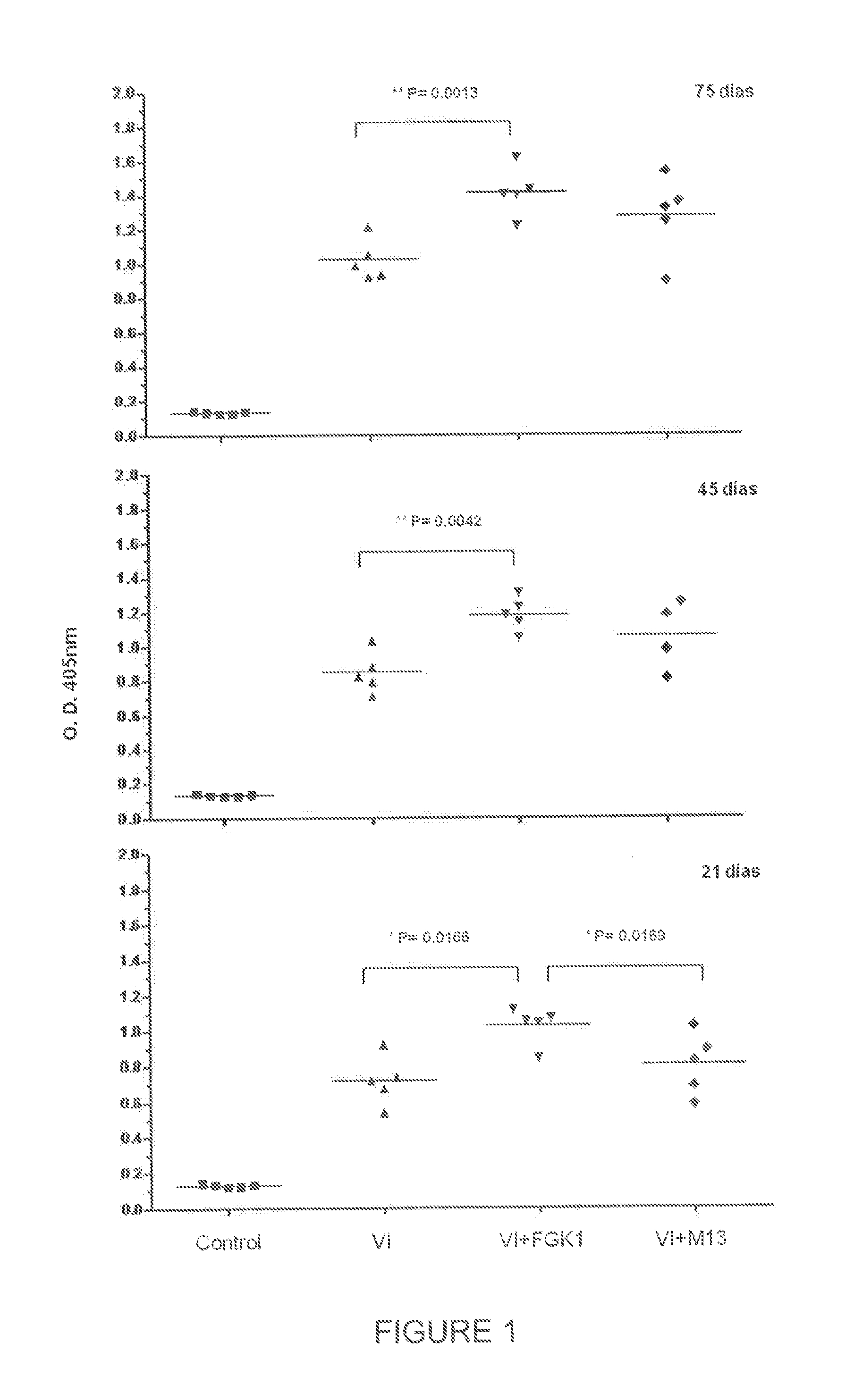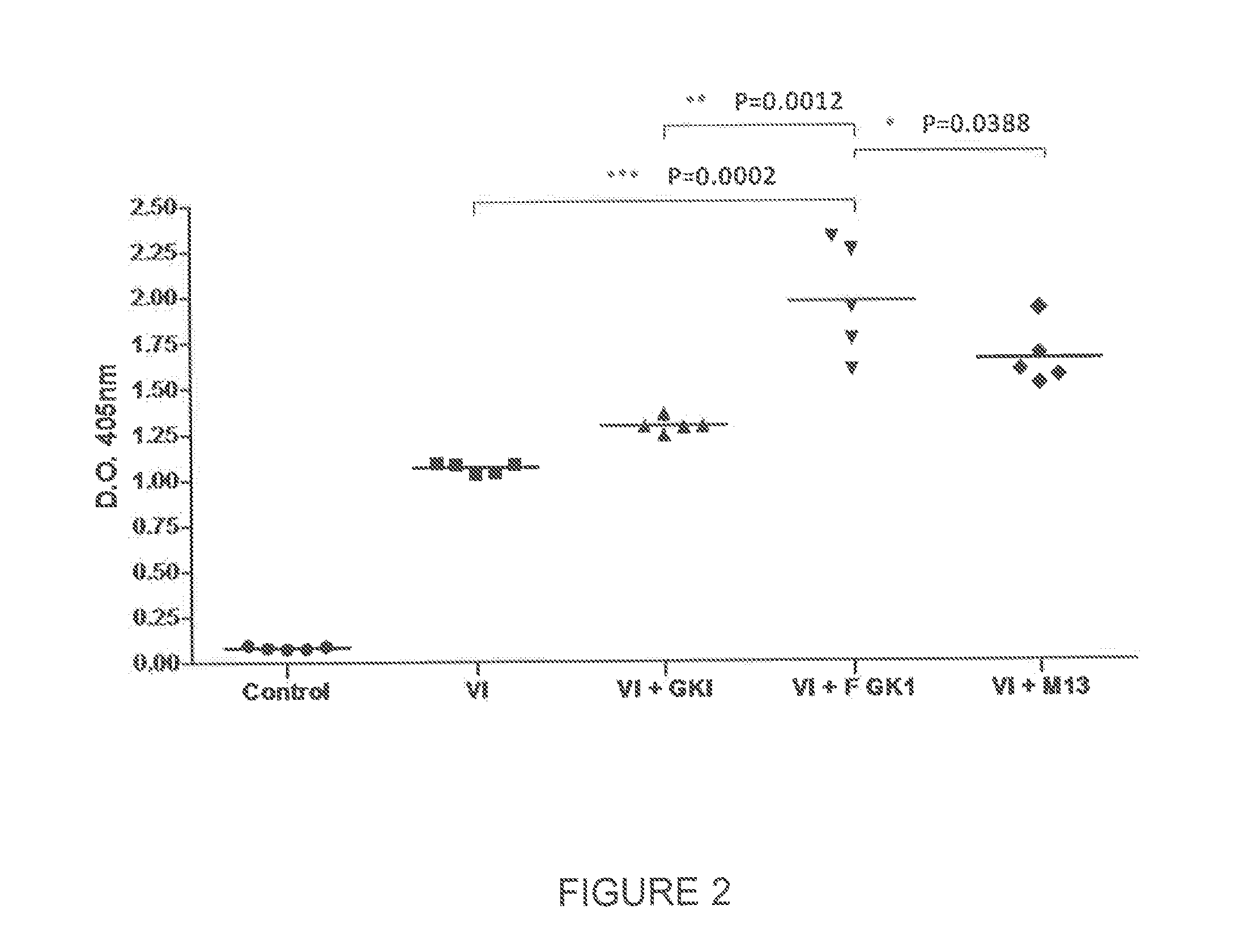Use of gk-1 peptide expressed on m13 filamentous phage as pharmaceutical ingredient to enhance the efficiency of the immune response induced by vaccine or pathogen antigens
a filamentous phage and gk-1 technology, applied in antibody medical ingredients, carrier-bound antigen/hapten ingredients, immunological disorders, etc., can solve the problems of insufficient, aluminum hydroxide specifically exacerbates a cellular response, and lacks adequate, so as to achieve the effect of protecting the immune respons
- Summary
- Abstract
- Description
- Claims
- Application Information
AI Technical Summary
Benefits of technology
Problems solved by technology
Method used
Image
Examples
example 1
Constructing the Gk-1 Phage Expressed on M13 Filamentous Phage (FGK-1)
[0048]To construct FGK-1, the GK-1 peptide was used; GK-1 was reported in the patent MX211604, which refers to the capacity of this peptide to enhance antigenic presentation, a phenomenon that mediates the vaccine-induced specific immune response. Additionally, an expression system called M13 was used; M13 was reported in the patent MXPA00008474A, which refers to the capacity of M13 to express vaccine antigens.
[0049]To perform the studies supporting the present invention, GK-1 peptide was recombinantly expressed.
[0050]GK-1 peptide is the sequence of amino acids 69-85 in the KETc7 antigen, and its specific sequence is GYYYPSDPNTFYAPPYSA. It was expressed on the surface of M13 phage by cloning the corresponding DNA in the phage / phagemid vector. The DNA fragment coding for GK-1 peptide was generated by aligning the synthetic oligonucleotides (Invitrogen) 5′GK1: AATTAGGTTATTACTATCCTATCTGATCCAAATACCTTCTACGCTCCACCCTACAG...
example 2
Determining the Effect of FGK-1 in Improving the Immune Response
[0053]To assess the effect of FGK-1 in improving the immune response elicited by vaccine antigens, the levels of induced specific antibodies were determined. This parameter was used to evaluate the effect of FGK-1 on the immune response. With the aim to determine the FGK-1 immunopotentiating effect, different lots of influenza vaccine, produced between 2001 and 2009, were used.
[0054]In each experiment, groups of female BALB / cAnN mice, 7-9 weeks of age, were used in a number varying according to the test to be performed. Mice received either subcutaneously or intranasally one single dose of each immunogen. Mice were sacrificed 45 days after immunization. Blood samples were collected before immunization, as well as 21 and 45 days after immunization, and bronchoalveolar lavage was collected on day 45.
Treatment Schedules Used were as Follows:
[0055]A first group was immunized with PBS, to be considered as negative control gr...
example 3
Determining the Effect of FGK-1 to Enhance the Immune Response Elicited by Viral Influenza Vaccine
[0058]To demonstrate the potentiating effect of FGK-1 on the immune response elicited by the influenza vaccine and to observe it at long times, four groups of female BALB / cAnN mice, 7-9 weeks of age, were used. The following treatment schedules were applied to the four groups:
[0059]Influenza vaccine was used at a dose of 1 μg / mouse [A / New Caledonia / 20 / 99(H1N1) strain, A / Panama / 2007 / 99(H3N2) strain (analog to A / Moscow / 10 / 99 strain), and B / Victoria / 504 / 2000 strain (analog to B / Sichuan / 379 / 99 strain)]. FLUZONE® vaccine for the flu season 2004-2005, containing 45 μg of hemagglutinin HA per 0.5 ml-dose, was used.
[0060]Mice received a single dose of each immunogen by subcutaneous route at the tail base, and the induced response was evaluated in serum after immunization, namely at 21, 45, and 75 days.
[0061]Sera were obtained from sampled peripheral blood, centrifuged at 5,000 rpm by 12 min, an...
PUM
| Property | Measurement | Unit |
|---|---|---|
| cross-reactivity | aaaaa | aaaaa |
| stability | aaaaa | aaaaa |
| volume | aaaaa | aaaaa |
Abstract
Description
Claims
Application Information
 Login to View More
Login to View More - R&D
- Intellectual Property
- Life Sciences
- Materials
- Tech Scout
- Unparalleled Data Quality
- Higher Quality Content
- 60% Fewer Hallucinations
Browse by: Latest US Patents, China's latest patents, Technical Efficacy Thesaurus, Application Domain, Technology Topic, Popular Technical Reports.
© 2025 PatSnap. All rights reserved.Legal|Privacy policy|Modern Slavery Act Transparency Statement|Sitemap|About US| Contact US: help@patsnap.com



